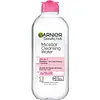Eveline Hyaluron Clinic Moisturising Micellar Water Versus Garnier Micellar Cleansing Water All-In-1
What's inside
What's inside
 Key Ingredients
Key Ingredients

No key ingredients
 Benefits
Benefits

 Concerns
Concerns

No concerns
 Ingredients Side-by-side
Ingredients Side-by-side

Water
Skin ConditioningPEG-6 Caprylic/Capric Glycerides
EmulsifyingOlive Oil PEG-7 Esters
EmollientCaprylyl/Capryl Glucoside
CleansingTetrasodium Glutamate Diacetate
Panthenol
Skin ConditioningCapryloyl Glycine
CleansingXylitylglucoside
HumectantHexylene Glycol
EmulsifyingParfum
MaskingCetrimonium Bromide
AntimicrobialCentella Asiatica Extract
CleansingCentella Asiatica Oil
AntimicrobialCalcium Citrate
BufferingPentylene Glycol
Skin ConditioningGlycerin
HumectantFructose
HumectantUrea
BufferingCitric Acid
BufferingSodium Hydroxide
BufferingMaltose
MaskingSodium PCA
HumectantSodium Chloride
MaskingSodium Lactate
BufferingTrehalose
HumectantAllantoin
Skin ConditioningSodium Hyaluronate
HumectantGlucose
HumectantMaris Aqua
HumectantHydrolyzed Algin
Sucrose
HumectantPhenethyl Alcohol
MaskingSodium Benzoate
MaskingDMDM Hydantoin
PreservativeIodopropynyl Butylcarbamate
PreservativeWater, PEG-6 Caprylic/Capric Glycerides, Olive Oil PEG-7 Esters, Caprylyl/Capryl Glucoside, Tetrasodium Glutamate Diacetate, Panthenol, Capryloyl Glycine, Xylitylglucoside, Hexylene Glycol, Parfum, Cetrimonium Bromide, Centella Asiatica Extract, Centella Asiatica Oil, Calcium Citrate, Pentylene Glycol, Glycerin, Fructose, Urea, Citric Acid, Sodium Hydroxide, Maltose, Sodium PCA, Sodium Chloride, Sodium Lactate, Trehalose, Allantoin, Sodium Hyaluronate, Glucose, Maris Aqua, Hydrolyzed Algin, Sucrose, Phenethyl Alcohol, Sodium Benzoate, DMDM Hydantoin, Iodopropynyl Butylcarbamate
 Reviews
Reviews

Ingredients Explained
These ingredients are found in both products.
Ingredients higher up in an ingredient list are typically present in a larger amount.
Glycerin is already naturally found in your skin. It helps moisturize and protect your skin.
A study from 2016 found glycerin to be more effective as a humectant than AHAs and hyaluronic acid.
As a humectant, it helps the skin stay hydrated by pulling moisture to your skin. The low molecular weight of glycerin allows it to pull moisture into the deeper layers of your skin.
Hydrated skin improves your skin barrier; Your skin barrier helps protect against irritants and bacteria.
Glycerin has also been found to have antimicrobial and antiviral properties. Due to these properties, glycerin is often used in wound and burn treatments.
In cosmetics, glycerin is usually derived from plants such as soybean or palm. However, it can also be sourced from animals, such as tallow or animal fat.
This ingredient is organic, colorless, odorless, and non-toxic.
Glycerin is the name for this ingredient in American English. British English uses Glycerol/Glycerine.
Learn more about GlycerinHexylene Glycol is a surfactant. Glycols are a class of alcohols. Hexylene Glycol is a surfactant and emulsifier.
As a surfactant, Hexylene Glycol helps gather dirt and oil on your skin to be washed away.
As an emulsifier, Hexylene Glycol helps keep water and oil together. This prevents them from separating in a product. Hexylene Glycol also thins out the texture of a product by lessening viscosity.
Hexylene Glycol has a small molecular weight.
Learn more about Hexylene GlycolWater. It's the most common cosmetic ingredient of all. You'll usually see it at the top of ingredient lists, meaning that it makes up the largest part of the product.
So why is it so popular? Water most often acts as a solvent - this means that it helps dissolve other ingredients into the formulation.
You'll also recognize water as that liquid we all need to stay alive. If you see this, drink a glass of water. Stay hydrated!
Learn more about Water